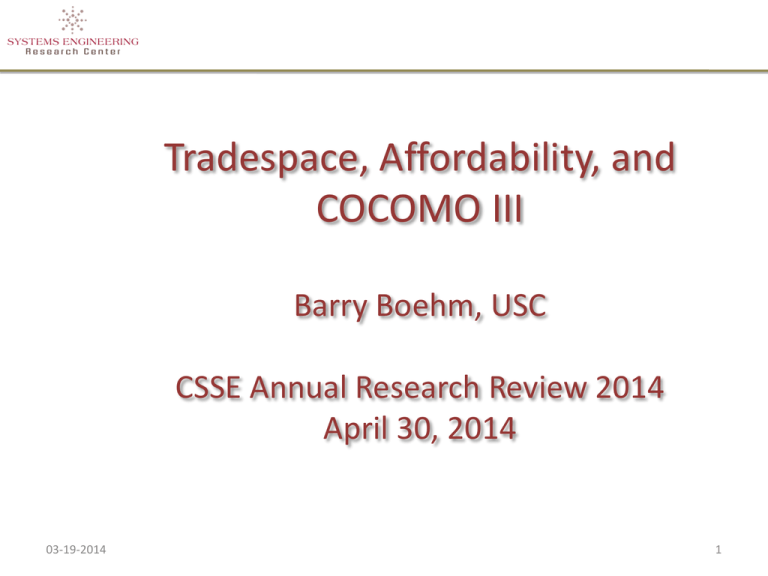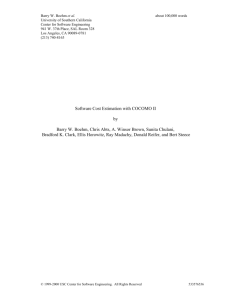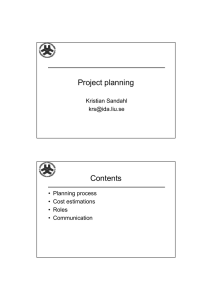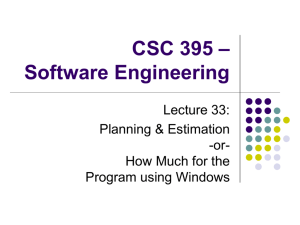Tradespace, Affordability and COCOMO iii
advertisement

Tradespace, Affordability, and COCOMO III Barry Boehm, USC CSSE Annual Research Review 2014 April 30, 2014 03-19-2014 1 Tradespace, Affordability and COCOMO III • Critical nature of the ilities – – – – Major source of project overruns, failures Significant source of stakeholder value conflicts Poorly defined, understood Underemphasized in project management • SERC Foundations efforts – – – – Stakeholder value-based, means-ends hierarchy Formal analysis of ility definitions and relations Architecture strategy synergies and conflicts Affordability means-ends hierarchy • Relations to COCOMO III 03-19-2014 2 Importance of ility Tradeoffs Major source of DoD system overruns • System ilities have systemwide impact – System elements generally just have local impact • ilities often exhibit asymptotic behavior – Watch out for the knee of the curve • Best architecture is a discontinuous function of ility level – “Build it quickly, tune or fix it later” highly risky – Large system example below 03-19-2014 3 Example of Current Practice • “The system shall have a Mean Time Between Failures of 10,000 hours” • What is a “failure?” – 10,000 hours on liveness – But several dropped or garbled messages per hour? • What is the operational context? – Base operations? Field operations? Conflict operations? • Most management practices focused on functions – Requirements, design reviews; traceability matrices; work breakdown structures; data item descriptions; earned value management • What are the effects on other –ilities? – Cost, schedule, performance, maintainability? 03-19-2014 4 USC: COCOMO II-Based Tradeoff Analysis Better, Cheaper, Faster: Pick Any Two? 9 (RELY, MTBF (hours)) 8 (VL, 1) Cost ($M) 7 (L, 10) 6 5 (N, 300) 4 (H, 10K) 3 (VH, 300K) •For 100-KSLOC set of features •Can “pick all three” with 77-KSLOC set of features 2 1 -- Cost/Schedule/RELY: “pick any two” points 0 0 10 20 30 40 50 Development Time (Months) 03-19-2014 5 Tradespace, Affordability and COCOMO III • Critical nature of the ilities – – – – Major source of project overruns, failures Significant source of stakeholder value conflicts Poorly defined, understood Underemphasized in project management • SERC Foundations efforts – – – – Stakeholder value-based, means-ends hierarchy Formal analysis of ility definitions and relations Architecture strategy synergies and conflicts Affordability means-ends hierarchy • Relations to COCOMO III 03-19-2014 6 SERC Value-Based ilities Hierarchy Based on ISO/IEC 9126, 25030; JCIDS; previous SERC research • Individual ilities – Mission Effectiveness: Speed, Physical Capability, Cyber Capability, Usability, Accuracy, Impact, Endurability, Maneuverability, Scalability, Versatility – Resource Utilization: Cost, Duration, Personnel, Scarce Quantities (capacity, weight, energy, …); Manufacturability, Sustainability – Protection: Security, Safety – Robustness: Reliability, Availablilty, Maintainability, Survivability – Flexibility: Modifiability, Tailorability, Adaptability – Composability: Interoperability, Openness, Service-Orientation • Composite ilities – – – – Comprehensiveness/Suitability: all of the above Dependability: Mission Effectiveness, Protection, Robustness Resilience: Protection, Robustness, Flexibility Affordability: Mission Effectiveness, Resource Utilization 03-19-2014 7 Means-Ends Framework: Affordability Get the Best from People Make Tasks More Efficient Affordability Improvements and Tradeoffs Eliminate Tasks Eliminate Scrap, Rework Simplify Products (KISS) Staffing, Incentivizing, Teambuilding Facilities, Support Services Kaizen (continuous improvement) Tools and Automation Work and Oversight Streamlining Collaboration Technology Lean and Agile Methods Task Automation Model-Based Product Generation Early Risk and Defect Elimination Evidence-Based Decision Gates Modularity Around Sources of Change Incremental, Evolutionary Development Value-Based, Agile Process Maturity Risk-Based Prototyping Value-Based Capability Prioritization Satisficing vs. Optimizing Performance Reuse Components Domain Engineering and Architecture Composable Components,Services, COTS Legacy System Repurposing Reduce Operations, Support Costs Automate Operations Elements Design for Maintainability, Evolvability Streamline Supply Chain Anticipate, Prepare for Change Value- and Architecture-Based Tradeoffs and Balancing 03-19-2014 8 Architecture Strategy Synergy-Conflict Matrix 03-19-2014 9 Software Development Cost vs. Quality 1.4 1.3 Relative Cost to Develop 1.26 1.2 1.1 1.10 1.0 1.0 0.9 0.8 0.92 0.82 Very Low Low Nominal High COCOMO II RELY Rating MTBF (hours) 03-19-2014 1 10 300 10,000 Very High 300,000 10 Software Ownership Cost vs. Quality 1.4 VL = 2.55 L = 1.52 1.3 Relative Cost to Develop, Maintain, Own and Operate Operational-defect cost at Nominal dependability = Software life cycle cost 1.26 1.2 1.23 1.20 1.1 1.0 1.10 1.10 1.05 1.07 1.11 Operational defect cost = 0 1.07 0.99 0.9 0.8 0.92 0.76 0.82 Very Low 0.69 Low Nominal High COCOMO II RELY Rating MTBF (hours) 03-19-2014 70% Maint. 1 10 300 10,000 Very High 300,000 11 03-19-2014 12 Tradespace, Affordability and COCOMO III • Critical nature of the ilities – – – – Major source of project overruns, failures Significant source of stakeholder value conflicts Poorly defined, understood Underemphasized in project management • SERC Foundations efforts – – – – Stakeholder value-based, means-ends hierarchy Formal analysis of ility definitions and relations Architecture strategy synergies and conflicts Affordability means-ends hierarchy • Relations to COCOMO III 03-19-2014 13 Affordability and Tradespace Framework Staffing, Incentivizing, Teambuilding Facilities, Support Services Kaizen (continuous improvement) Get the Best from People Make Tasks More Efficient Affordability Improvements and Tradeoffs Tools and Automation Work and Oversight Streamlining Collaboration Technology Lean and Agile Methods Eliminate Tasks Task Automation Model-Based Product Generation Early Risk and Defect Elimination Evidence-Based Decision Gates Modularity Around Sources of Change Incremental, Evolutionary Development Value-Based, Agile Process Maturity Eliminate Scrap, Rework Risk-Based Prototyping Simplify Products (KISS) Value-Based Capability Prioritization Satisficing vs. Optimizing Performance Reuse Components Domain Engineering and Architecture Composable Components,Services, COTS Legacy System Repurposing Reduce Operations, Support Costs Value- and Architecture-Based Tradeoffs and Balancing 14 03-19-2014 Automate Operations Elements Design for Maintainability, Evolvability Streamline Supply Chain Anticipate, Prepare for Change Costing Insights: COCOMO II Productivity Ranges Scale Factor Ranges: 10, 100, 1000 KSLOC Development Flexibility (FLEX) Staffing Team Cohesion (TEAM) Develop for Reuse (RUSE) Teambuilding Precedentedness (PREC) Continuous Improvement Architecture and Risk Resolution (RESL) Platform Experience (PEXP) Data Base Size (DATA) Required Development Schedule (SCED) Language and Tools Experience (LTEX) Process Maturity (PMAT) Storage Constraint (STOR) Use of Software Tools (TOOL) Platform Volatility (PVOL) Applications Experience (AEXP) Multi-Site Development (SITE) Documentation Match to Life Cycle Needs (DOCU) Required Software Reliability (RELY) Personnel Continuity (PCON) Time Constraint (TIME) Programmer Capability (PCAP) Analyst Capability (ACAP) Product Complexity (CPLX) 1 1.2 1.4 1.6 1.8 2 2.2 Productivity Range 15 03-19-2014 2.4 COSYSMO Sys Engr Cost Drivers Teambuilding Continuous Improvement Staffing 03-19-2014 16 Tradespace and Affordability Framework Staffing, Incentivizing, Teambuilding Facilities, Support Services Kaizen (continuous improvement) Get the Best from People Make Tasks More Efficient Tools and Automation Work and Oversight Streamlining Collaboration Technology Affordability Improvements and Tradeoffs Lean and Agile Methods Eliminate Tasks Task Automation Model-Based Product Generation Early Risk and Defect Elimination Evidence-Based Decision Gates Modularity Around Sources of Change Incremental, Evolutionary Development Value-Based, Agile Process Maturity Eliminate Scrap, Rework Risk-Based Prototyping Simplify Products (KISS) Value-Based Capability Prioritization Satisficing vs. Optimizing Performance Reuse Components Domain Engineering and Architecture Composable Components,Services, COTS Legacy System Repurposing Reduce Operations, Support Costs Automate Operations Elements Design for Maintainability, Evolvability Streamline Supply Chain Anticipate, Prepare for Change Value- and Architecture-Based Tradeoffs and Balancing 17 03-19-2014 Value-Based Testing: Empirical Data and ROI — LiGuo Huang, ISESE 2005 100 (a) % of Value for Correct Customer Billing Bullock data – Pareto distribution 80 60 Automated test generation (ATG) tool - all tests have equal value 40 20 5 10 15 Customer Type (b) Return On Investment (ROI) 2 1.5 1 0.5 0 0 10 20 30 40 50 60 70 80 -0.5 -1 -1.5 % Tests Run Value-Neutral ATG Testing 03-19-2014 18 Value-Based Pareto Testing 90 100 Value-Neutral Defect Fixing Is Even Worse Pareto 80-20 Business Value 100 Automated test generation tool - all tests have equal value 80 % of Value for Correct Customer Billing 60 40 Value-neutral defect fixing: Quickly reduce # of defects 20 5 10 15 Customer Type 03-19-2014 19 Product Line Engineering and Management: NPS 02-25-14 20 SysML Building Blocks for Cost Modeling GaTech-USC Work in RT46 Phase 2 (Oct-Dec 2013) • Implemented reusable SysML building blocks – Based on SoS/COSYSMO SE cost (effort) modeling work by Lane, Valerdi, Boehm, et al. • Successfully applied building blocks to healthcare SoS case study from [Lane 2009] • Provides key step towards affordability trade studies involving diverse “-ilities” (see MIM slides) 21 Healthcare SoS Case Study [Lane 2009] Implemented Using SysML Building Blocks: Selected SysML Diagrams 22 Tradespace, Affordability and COCOMO III • Critical nature of the ilities – – – – Major source of project overruns, failures Significant source of stakeholder value conflicts Poorly defined, understood Underemphasized in project management • SERC Foundations efforts – – – – Stakeholder value-based, means-ends hierarchy Formal analysis of ility definitions and relations Architecture strategy synergies and conflicts Affordability means-ends hierarchy • Relations to COCOMO III 03-19-2014 23 COCOMO II Data by 5-Year Periods 1/13/2014 © USC-CSSE 24 COCOMO II Data: Productivity Trends 1/13/2014 © USC-CSSE 25 COCOMO II Data: Process Maturity Trends 1/13/2014 © USC-CSSE 26 SRDR Data: Productivity vs. Size, CMM Level 400 350 300 250 0-1 EKSLOC 1-10 EKSLOC 200 10-50 EKSLOC 50-100 EKSLOC 150 >100 EKSLOC 100 50 0 CMM 2 1/13/2014 CMM 3 CMM 4 CMM 5 CMMI 3 © USC-CSSE CMMI 4 CMMI 5 27 Trends Confounded by Missing Variables Incremental Development Productivity Decline QMP 12 10 8 Productivity 6 Linear (Productivity) Log. (Productivity) 4 y = -0.7989x + 8.5493 R² = 0.3693 2 y = -2.708ln(x) + 8.7233 R² = 0.5326 0 1 12/03/2013 2 3 4 5 Copyright © USC-CSSE 6 28 COCOMO II Status and COCOMO III Plans • Baseline COCOMO II calibrated to 161 project data points – Pred (20%; 30%) = (63%; 70%) general; (75%;80%) local • Added 149 data points 2000-2009 – Pred (30%) < 40% general; some sources ~70-80% local – Some improvement with added variables (year; domain; agility) • But some data-source mismatches unexplainable • Vu Nguyen analysis of full dataset suggests further adjusting – Rating scales for experience, tools, reliability • Proposed approach for COCOMO III – Explore models for unexplained existing sources or drop – Try added variables for mostly-general fit to existing data – Obtain more data to validate results 1/13/2014 © USC-CSSE 29




